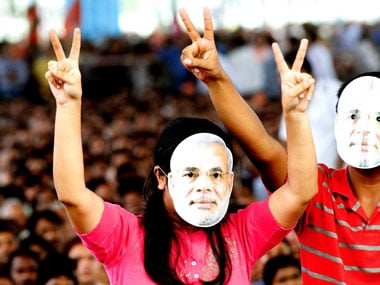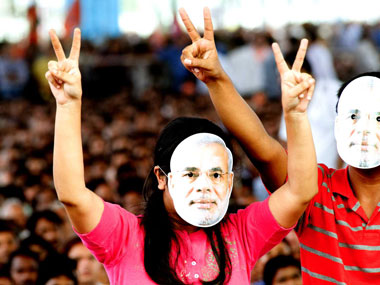As 2013 draws to a close, two people have come to dominate the political landscape in India – Arvind Kejriwal of the Aam Aadmi Party (AAP) and Narendra Modi of the BJP. Even though Modi dominated the discourse for much of the earlier part of the year, Kejriwal finished a nose ahead of Modi after December’s state assembly elections. 2014 will continue to be about their covert rivalry, even though Rahul Gandhi will get his share of the media. The Gandhi scion has probably woken up a bit too late to make a difference to the outcome in 2014, but Kejriwal has risen just in time to rain on Modi’s party. This means the outcome in 2014 can go in any direction. [caption id=“attachment_131365” align=“alignleft” width=“380”]  Naresh Sharma/ Firstpost[/caption] The big question of 2014 thus is not whether the Congress will lose, but how badly, and what impact the rise of AAP will have on BJP’s rising trajectory. To speculate on this, it is important to understand where their support is coming from, and also the vagaries of the first-past-the-post (FPTP) Indian electoral system. Yesterday (28 December), speaking in Ranchi, Narendra Modi attacked Rahul Gandhi, but if he continues to believe that the Congress party is his main or only adversary, he is likely to be proved wrong in 2014. He cannot anymore pretend that AAP is a localised challenge because their urban voter bases overlap. On the other hand, the FPTP system could ensure an outcome both favourable or unfavourable to the BJP depending on how the non-BJP votes split. Let’s see how AAP and BJP are both similar and dissimilar to start the discussion. Both Kejriwal and Modi are outsiders challenging the political status quo. While AAP is positioned against all current major political parties, BJP under Modi is specifically positioned as someone outside the corrupt Delhi consensus. Both appeal to the urban middle classes, but a bit differently. AAP promises clean politics, and BJP promises governance. AAP’s clean politics is not the same as the Modi’s claim to better governance, for the former is a kind of protest against existing venality, while the latter is about delivering governance based on Modi’s track record in Gujarat. Both use the social media effectively for spreading the message. But there are small points of divergence in their social media support as well. While AAP’s social media messaging is driven by a set of committed volunteers, Modi’s messaging is driven by a group close to Modi. However, their actual support bases are driven by genuine supporters – even if you want to call them trolls. While Kejriwal’s support comes from uncommitted voters who want sane politics, Modi’s support comes from a group of middle class and (possibly Hindu) audience that feels excluded from the mainstream media consensus. Both AAP and Modi support bases are thus passionate in their beliefs, but some of it may be common. This is one reason why AAP and BJP are rivals. But there are significant points of divergence, too. Kejriwal is a man of the people – almost literally. He likes to move among them and vibes well with them. Modi likes to talk to his people from a distance. This could be for security reasons – for Modi is likely to be the most vulnerable politician in India right now – but it is also likely to be the result of Modi’s own aloof persona. Few people really manage to get close to Modi – and this may not be a good thing however well Modi communicates to a public audience or sways crowds. Another difference is the track record. The absence of a track record works to Kejriwal’s advantage; people attacking him are attacking a phantom. Modi’s track record has both negatives and positives (2002 and subsequent good governance), and hence more vulnerable to scrutiny and attacks. A third difference is the attitude of the vested interests threatened by Modi and Kejriwal. The Left-liberal anti-BJP Delhi consensus is a very powerful force in media and hence is swinging behind Kejriwal right now because he has established his political viability. Fear of Modi makes the Delhi media pro-Kejriwal. Modi threatens the Delhi vested interests more than Kejriwal for the simple reason that he carries more clout and he could go after them with a vengeance if he becomes PM. Kejriwal, on the other hand, threatens the system more than specific individuals, and hence the resistance to his clean politics will surface only over time. The system will fight back, but not right now. This gives Kejriwal a short-term advantage over Modi. Modi does not threaten the overall system, only the Delhi caucuses of power. A fourth point of divergence is their ideology. AAP is centre-Left, and BJP is centre-Right. Logically, this positioning should make AAP eat more into Congress votes than BJP, but since both are stronger in urban areas, one can’t presume the damage to BJP will be less from AAP (as Delhi proved). A fifth difference is that Kejriwal can promise the moon everywhere since he is not in power. The BJP is in power in many states, and cannot promise anything that is too irresponsible – especially if it is a contender for power at the centre in 2014. Whatever it promises, it will have to deliver, and right now the centre’s finances are in a mess. To his credit, Modi has not gone around promising free water or power to anybody, which shows him to be fiscally more responsible than Kejriwal. But then this is not necessarily an advantage if others can promise freebies to all and sundry. The key takeout from the above are the following: - BJP will be in direct competition with AAP, even if AAP eats more into the Congress vote, especially in urban areas. So if BJP leaders like Rajnath Singh and Nitin Gadkari pooh-pooh the AAP threat, they are living in a fool’s paradise. - It is possible that some AAP voters even in Delhi will vote for Modi, but this vote will have to be seriously canvassed and earned. It will not automatically flow to Modi in a general election. - The BJP will face serious competition in Delhi, Haryana and Maharashtra’s urban areas from AAP due to media focus. - Even after all this, one cannot be sure how the vote will actually split in 2014 because of the first-past-the-post (FPTP) system. FPTP ensures that you need only around 30-35 percent of the vote to reap a huge tally of seats (or even a majority), and in 2014 many seats will be four-cornered, with BJP, Congress, a regional party and/or AAP competing for votes in urban seats. - One cannot rule out a landslide for the BJP in such a scenario either, but one cannot rule out a very poor additional haul too (just 150-160 seats) if its rivals manage to get their acts together. For example, what if the Congress ties up with Mayawati in Uttar Pradesh, and with Nitish Kumar (now seemingly unlikely) in Bihar? - One thing is certain: the BJP is likely to see a huge increase in popular votes – maybe an accretion of at least 30-40 percent more than last time, but it needs a seat gain that’s higher than this percentage increase to win 200 seats. This is the real challenge for BJP under Modi. - As for AAP, it could reap many votes and still not win enough seats - just as the BSP did for several seats. A 5-10 percent vote share all over India will not give AAP 5-10 percent of the total seats. It’s best bet is in urban areas.
It is now impossible to predict 2014. The game was heading Modi’s way till recently, but AAP is now a serious contender for Modi’s vote in several important pockets
Advertisement
End of Article
Written by R Jagannathan
R Jagannathan is the Editor-in-Chief of Firstpost. see more


)
)
)
)
)
)
)
)
)



